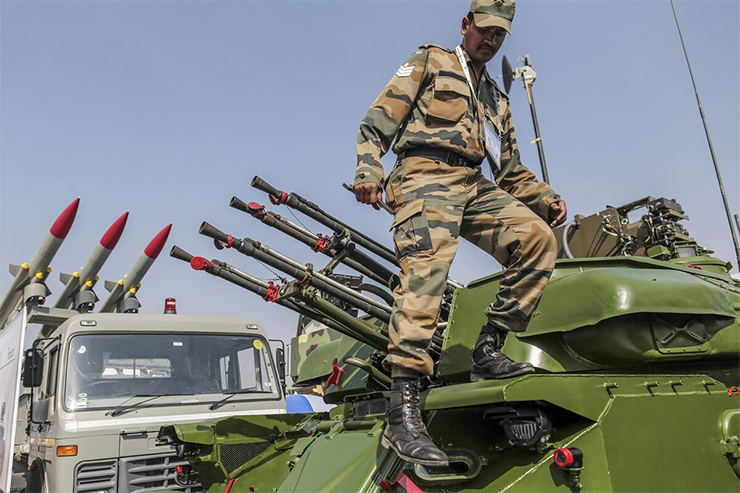
Ensuring self-sufficiency in defence stands as the foremost pillar of strategic independence. In the days ahead, the significance of nurturing indigenous industries will grow, not just to cater to India’s needs but also to establish itself as a capable exporter. Despite past endeavours towards self-reliance since its independence, India has faced challenges and experienced less-than-desirable outcomes. The country initially built its domestic defence production facilities with the assistance of nations like the former USSR and the British in the 1960s and 1970s, primarily through licensed assembly.
The clarion call for ‘Aatmanirbhar Bharat’ has breathed new life into the vision of self-reliance. This vision, championed by Prime Minister Narendra Modi, gained momentum on May 12 in 2020, when a special economic and comprehensive package of Rs 20 lakh crore (approximately 10 per cent of India’s GDP) was unveiled to bolster India’s self-reliance and tackle the challenges posed by the COVID-19 pandemic. Aatmanirbhar Bharat is built on five pillars: Economy, Infrastructure, System, Vibrant Demography, and Demand.
India’s pursuit of self-sustainability is not rooted in a self-centred approach. On the contrary, it embraces a global outlook, seeking the happiness, cooperation, and peace of the entire world community – Vasudhaiva Kutumbakam.
The defence sector has emerged as a crucial area offering numerous opportunities for India’s self-reliance, given its significance in the Indian economy. With a vast pool of skilled human resources and the Indian Armed Forces’ modernisation needs, this sector holds immense potential for remarkable growth. By capitalising on this potential, the defence industry can play a pivotal role in strengthening the economy, creating substantial employment opportunities, and easing the burden on the exchequer by reducing import dependence.
As of 2020-21, the overall size of the Defence Industry, which encompasses the Aerospace and Naval Shipbuilding segments, was estimated to be Rs 85,000 crore. While the public sector’s contribution stands at Rs 68,000 crore, the private sector has steadily expanded its share and now accounts for more than Rs 17,000 crore in recent years.
To foster the indigenous design, development, and manufacturing of defence equipment, the government has taken proactive policy measures. These initiatives aim to establish a sustainable and self-reliant defence industrial ecosystem in the country.
- A crucial step towards achieving self-reliance in defence is the revised Defence Acquisition Procedure (DAP)-2020, which encourages sourcing capital goods from the domestic market.
- The government has taken significant strides by announcing Positive Indigenisation Lists comprising 209 items of goods and services, along with 2851 items from Defence Public Sector Undertakings (DPSUs). Import restrictions have been imposed on these items, promoting indigenous production.
- The Industrial licensing process has been simplified with extended validity, while Foreign Direct Investment (FDI) policy has been revamped, allowing 74 per cent FDI under the automatic route and 100 per cent with government approval, facilitating foreign investment in the defence sector.
- The Innovations for Defence Excellence (iDEX) scheme has been launched to foster collaboration with start-ups and Micro, Small, and Medium Enterprises (MSMEs) in driving innovation and technology development.
- The implementation of the Public Procurement (Preference to Make in India) Order 2017 further supports indigenous manufacturing, promoting domestic products and services in defence procurement.
- The offset policy now emphasizes attracting investment and technology transfer for Defence manufacturing through higher multipliers.
- To boost the defence industry, two dedicated Defence Industrial Corridors have been established, one in Uttar Pradesh and the other in Tamil Nadu.
- A strategic restructuring of the Ordnance Factory Board into seven new Defence Companies has been undertaken, and the Ministry of Defence (MoD) has issued an action plan to ensure the timely finalisation of contracts for all Capital Acquisition cases within two years of approval.
In pursuit of advancing and strengthening the capabilities of the Indian Armed Forces, the annual budget for the defence sector in 2022-23 witnessed a significant increase of 12.82 per cent compared to the previous year. The government’s focus on reducing import dependence and promoting indigenous technology has led to a gradual rise in the domestic industry’s capital procurement budget, reaching 68 per cent for the year 2022-23. This move opens up abundant opportunities for the domestic sector and facilitates the modernisation of our Armed Forces through home-grown innovations.
The symbiotic relationship between modernisation requirements and a robust design and production ecosystem is evident. For achieving the ambitious target of a turnover of Rs 1,75,000 crore and exports worth Rs 35,000 crore in the Defence sector by 2025, a strong emphasis on research and development (R&D) and technological advancement becomes paramount. The true essence of Aatmanirbharta (self-reliance) in Defence goes beyond mere production; it encompasses nurturing and evolving indigenous capabilities in existing and emerging technologies. This entails fostering design leadership within industry, start-ups, and academia alike.
By prioritising innovation, R&D, and design excellence, India can actualise its vision of self-reliance in the Defence sector. This approach not only enhances our Armed Forces’ capabilities but also strengthens the position of the domestic defence industry in the global arena, driving growth and prosperity for the nation.
Trial and testing of goods and services play a crucial role in the research and development (R&D) process, particularly in the Defence sector. However, in India, this aspect is still in its initial phase and requires significant support to attain global competitiveness in terms of both price and quality. Several key factors impact the growth of the promising defence industry, including delays in trials and testing processes, the unavailability of proof stock components, and limited access to comprehensive test amenities, leading to increased transportation costs and long waiting times. To foster sustainable development in the Design and Development system, access to up-to-date testing infrastructure becomes essential.
To address these challenges, the Ministry of Defence (MoD) has taken steps to establish 134 Test Labs and 25 Proof Ranges/Field Firing Ranges across the country, providing support to the industry in testing and validation.
Introducing Special Purpose Vehicles (SPVs) for major defence systems is another strategic move that aims to streamline the entire procedure. By involving the industry right from the initiation of Defence Design & Development projects, the SPVs make them essential stakeholders in the complete process, leading to the production of various products and services. These SPVs will be responsible for overseeing the series production of equipment and exploring export opportunities, further bolstering India’s self-reliance in the Defence sector.
The ongoing Ukraine-Russian conflict, while too early to draw military lessons from, has underscored two critical aspects. First, the significance of information warfare, economic sanctions, and social media in modern conflicts; and second, the importance of self-reliance in defence capabilities. India has recognised the value of self-sufficiency in the Defence sector. However, to avoid any knee-jerk reactions in the future, a clear road map for indigenous development needs to be in place, enabling India to chart a steady course towards bolstering its defence capabilities.
A strong and well-equipped military serves as a shield, providing a nation with immunity against external and internal risks. It reflects a country’s military prowess and its capacity to defend itself against any potential threat. In this context, the modernisation of military capabilities and the incorporation of cutting-edge technology are of paramount importance. For India, building a robust and technologically advanced military force is essential to fortify its security, enhance intelligence capabilities, and safeguard its territorial integrity.
India’s aspirations to become a global superpower necessitate the modernisation of its Armed Forces. The ongoing threats from its immediate neighbourhood only reinforce the urgency for such advancements. Unresolved boundary disputes with China and Pakistan, terrorism in Jammu and Kashmir, insurgency in the North-Eastern states, the menace of left-wing extremism, and the emerging challenges of urban terrorism have created a complex security environment for India. In order to effectively counter these threats and engage in modern warfare, India must equip its Armed Forces with state-of-the-art weaponry and defence systems.
The present moment offers an opportune time to move beyond complacency, taking proactive steps to usher in a new era of military strength and preparedness. By embracing technological advancements and strategic modernisation, India can position itself among the elite militaries of the world. The goal is not only to secure its own nation but also to contribute to global peace and stability.
The path to India’s growth as a military power lies in its resolute commitment to modernisation and adaptation to the changing security landscape. By embracing innovation and making proactive decisions, India can establish itself as a formidable force, capable of safeguarding its interests and contributing to a safer world.
–The author of this article is a Defence, Aerospace & Political analyst based in Bengaluru. The views expressed are of the author and do not necessarily reflect the views of Raksha Anirveda











